Disclosure: We may earn commissions if you purchase products after clicking on a link from our site.
Do you want to test your fishing skills by fishing for alligator gar? Would you like to learn how to catch alligator gar? Gar grows to a very large fish and it is not uncommon to find some that weigh 100 pounds. Fishing for gar can be challenging as it is hard to target.
Catching alligator gar will put your fishing skills as well as your patience to the test. In this article, we discuss fishing for gar to help you catch this pre-historic looking fish.
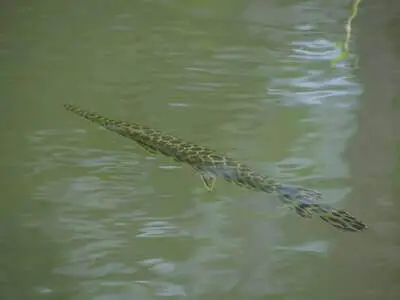
Table of Contents
- 1 Where Can I Find Alligator Gar
- 2 How To Catch Alligator Gar
- 3 1. Bowfishing
- 4 2. Fly Fishing
- 5 3. Rod and Reel
- 6 4. Topwater Fishing
- 7 5. Jug Fishing
- 8 6. Limblines
- 9 7. Trotlines
- 10 8. Noodling
- 11 Alligator Gar Tackle
- 12 Best Baits For Alligator Gar
- 13 Best Lures For Alligator
- 14 Alligator Gar Fishing Tips
- 15 The Bottom Line
Where Can I Find Alligator Gar
Gar is usually found in slow-moving, brackish waters. It can also be found in ponds, lakes, rivers, and creeks. Gar can also be found in the salt waters of the Gulf Coast.
Gar will always move to the deeper areas of water bodies that are characterized by long, flat open spaces and a good flow.
Moreover, gar can also be found in areas where the water flow is stagnant and the oxygen levels are low. They can breathe air from the water’s surface using an organ that makes this possible. This explains how it lives a long life in stagnant ponds and lakes.
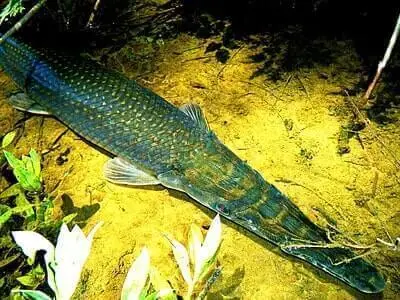
How To Catch Alligator Gar
There are many fishing methods that anglers use when fishing for gar. Some are bowfishing, rod and reel fishing, fly fishing, topwater fishing, and passive gear such as jug fishing, limblines, and trotlines.
1. Bowfishing
Bowfishing is a specialized method for targeting alligator gar that combines archery skills with fishing techniques. Anglers use specially designed bows equipped with reels and heavy arrows to shoot and retrieve alligator gar from the water.
Bowfishing is often conducted in shallow, clear waters where alligator gar is visible near the surface. Anglers must have a keen eye and precise aim to successfully land these elusive fish. Bowfishing for alligator gar requires proper licensing and adherence to regulations to ensure ethical and sustainable harvesting practices.
It’s essential to familiarize oneself with local laws and guidelines for bow fishing and alligator gar conservation. Stay informed about regulations and best practices for alligator gar fishing by consulting resources provided by the U.S. Fish and Wildlife Service.
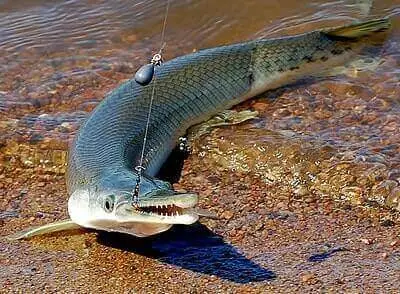
2. Fly Fishing
Fly fishing for alligator gar presents a unique and challenging angling experience, combining the artistry of fly casting with the thrill of targeting one of North America’s most formidable freshwater predators. Anglers pursuing alligator gar with fly fishing gear typically use heavy-duty fly rods, large reels, and specialized fly patterns designed to imitate the prey species of these ancient fish.
The technique involves casting the fly near structures where alligator gar are known to congregate, such as submerged logs, weed beds, or shallow flats, and enticing them to strike by imparting lifelike movement to the fly. Due to the gar’s ambush hunting behavior, presentation accuracy and timing are crucial, requiring anglers to cast with precision and patience.
Once a gar takes the fly, anglers must set the hook firmly and be prepared for a powerful battle, as these prehistoric fish are renowned for their strength and endurance. Fly fishing for alligator gar requires a deep understanding of the fish’s behavior, as well as proficiency in casting and fly manipulation techniques.
As with any angling pursuit, it’s essential to prioritize conservation and responsible fishing practices to ensure the sustainability of alligator gar populations. Stay informed about regulations and best practices for fly fishing for alligator gar by consulting resources provided by the U.S. Fish and Wildlife Service.
3. Rod and Reel
Rod and reel fishing is a traditional and popular method for targeting alligator gar. Anglers typically use heavy-duty tackle, including strong rods, large reels, and heavy lines, to handle the immense size and power of these prehistoric fish.
Live bait such as large fish, carp, or small mammals is commonly used to entice alligator gar, with rigs set up to allow the bait to move naturally in the water. Anglers cast their bait into areas known to hold alligator gar, such as deep pools, backwaters, and along the edges of rivers and lakes. Patience is essential when fishing for alligator gar, as these fish can be cautious and selective feeders.
It’s crucial to stay informed about regulations and best practices for alligator gar fishing to ensure sustainable angling practices. For more information on alligator gar fishing regulations and conservation efforts, consult the resources provided by the U.S. Fish and Wildlife Service.
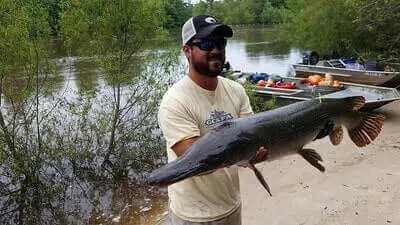
4. Topwater Fishing
Topwater fishing is a thrilling and visually captivating method used to target alligator gar. Anglers employ large, surface-floating lures, such as topwater plugs or large floating baits, to entice these formidable fish to strike. The technique involves casting the lure onto the water’s surface and using a jerking or popping motion to create commotion and attract the attention of nearby alligator gar.
As these ancient predators are known to be opportunistic feeders, they often respond aggressively to the disturbance caused by the topwater lure, lunging from beneath the surface to strike with explosive force. Topwater fishing for alligator gar requires patience, skill, and precise timing, as anglers must anticipate the moment when a gar will strike and set the hook with a swift, decisive motion.
This method provides an exhilarating angling experience, offering the chance to witness the powerful strikes and acrobatic leaps of these prehistoric fish. However, it’s crucial to use appropriate tackle and exercise caution when targeting alligator gar to ensure the safety of both the angler and the fish. Stay informed about regulations and best practices for alligator gar fishing by consulting resources provided by the U.S. Fish and Wildlife Service.
5. Jug Fishing
Jug fishing is a passive method commonly used to target alligator gar in slow-moving rivers, lakes, and backwaters. Anglers set out multiple jugs, bottles, or floats rigged with baited lines and anchors to drift along the water’s surface.
Alligator gar are attracted to the scent of the bait and may strike the baited lines as they drift by. Anglers periodically check the jugs and retrieve any fish caught, including alligator gar. Jug fishing can be an effective way to cover a large area of water and increase the chances of encountering alligator gar.
However, it’s essential to use biodegradable materials for jug fishing to minimize environmental impact and ensure the safety of aquatic wildlife. Stay informed about regulations and best practices for alligator gar fishing by consulting resources provided by the U.S. Fish and Wildlife Service.
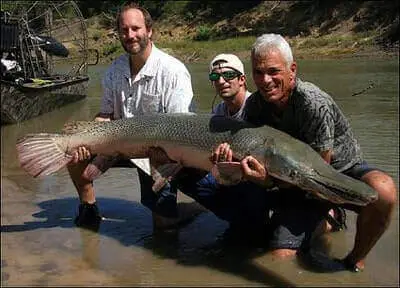
6. Limblines
Another fishing method used by anglers when fishing for alligator gar is to use limblines. Limblines are fishing lines that hang from the limb of an overhanging tree. This setup is used to make it easy to catch an alligator gar and control it.
7. Trotlines
Setline fishing, also known as trotline fishing, involves setting out long lines with multiple baited hooks to passively catch alligator gar. Anglers secure one end of the setline to a fixed object such as a tree, stump, or buoy and anchor the other end to keep it taut in the water. Baited hooks spaced at intervals along the setline attract alligator gar as they swim by, allowing anglers to catch multiple fish simultaneously.
Setline fishing is a popular method for targeting alligator gar in rivers, lakes, and other bodies of water where these fish are known to inhabit. However, it’s essential to use setlines responsibly and by local regulations to minimize bycatch and protect alligator gar populations. Stay informed about regulations and best practices for alligator gar fishing by consulting resources provided by the U.S. Fish and Wildlife Service.
8. Noodling
Noodling, also known as hand fishing or grabbling, is a daring method used to catch alligator gar in their natural habitat. Anglers wade into shallow waters and use their hands to locate and capture alligator gar hiding in underwater structures such as hollow logs, rock crevices, or submerged vegetation.
This technique requires skill, courage, and a deep understanding of alligator gar behavior. Anglers must exercise caution when noodling for alligator gar, as these fish can deliver powerful bites and may pose safety risks.
Noodling is often practiced by experienced anglers seeking an adrenaline-fueled challenge, but it’s essential to prioritize safety and conservation while engaging in this activity. Stay informed about regulations and best practices for alligator gar fishing by consulting resources provided by the U.S. Fish and Wildlife Service.
Alligator Gar Tackle
A 7-8 foot rod with a spinning reel will work well when fishing for gar. Additionally, an 80-pound test braided line should be the least that you use when fishing for alligator gar. Use a 4/0 or 5/0 small hook or j hook. Some anglers go with a treble hook, although you can use a single hook.
Moreover, a cut-resistant or steel leader will be the best choice when fishing for alligator gar as they have very sharp teeth and can easily and quickly break a strong braided line. The steel leader should be about 30 inches long to prevent the alligator gar from snagging your main line.
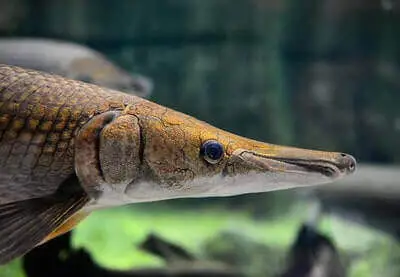
Best Baits For Alligator Gar
Alligator gars eat a good number of baitfish that anglers can use as bait when fishing for gar. When gar fishing, look for schools of baitfish that seem to be felling a predator. Most times, it will be alligator gar in pursuit.
1. Carp
Using carp as bait for alligator gar can be highly effective due to the large size and strong scent of carp, which can attract these powerful freshwater predators. Anglers targeting alligator gar often employ carp as live bait, cut bait, or even as whole carcasses suspended beneath floats or rigged on heavy-duty tackle.
Carp are commonly found in the same habitats as alligator gar, such as slow-moving rivers, backwaters, and reservoirs, making them readily available and natural prey for gar. When using carp as bait, anglers should select healthy specimens and rig them securely to withstand the gar’s sharp teeth and powerful strikes.
Additionally, carp can be combined with attractants or scent enhancers to further entice alligator gar. Anglers should check local regulations regarding the use of carp as bait and practice ethical fishing methods to minimize harm to both the baitfish and the target species.
Staying informed about best practices for using carp as bait for alligator gar can help anglers maximize their chances of success while promoting sustainable fishing practices. For more information on responsible angling techniques and regulations, consult resources provided by the U.S. Fish and Wildlife Service.
2. Mullet
Using mullets as bait for alligator gar can be an effective strategy due to the size and oiliness of mullet, which can attract these large predatory fish. Mullets are commonly found in the same freshwater habitats as alligator gar, such as slow-moving rivers, marshes, and estuaries, making them a natural prey item for gar.
Anglers often use mullet as live bait, cut bait, or even as whole fish rigged on heavy-duty tackle. Live mullet can be particularly enticing to alligator gar, as their lively swimming action can trigger aggressive strikes. When using mullet as bait, anglers should ensure they are using fresh and lively specimens, as gar are more likely to be attracted to actively swimming prey.
Rigging mullets securely to withstand the gar’s sharp teeth and powerful strikes is also essential for success. Additionally, anglers may choose to enhance the scent trail of mullet bait using attractants or natural oils to further entice alligator gar.
It’s important for anglers to check local regulations regarding the use of mullet as bait and to practice ethical fishing methods to minimize harm to both the baitfish and the target species. For more information on responsible angling techniques and regulations, consult resources provided by the U.S. Fish and Wildlife Service.
3. Shad
Using shad as bait for alligator gar can be highly effective due to the natural abundance of shad in freshwater habitats where alligator gar is commonly found. Shad are a preferred prey species for many predatory fish, including alligator gar, because of their size, abundance, and oily flesh, which emits a strong scent trail in the water.
Anglers often use shad as live bait, cut bait, or even whole fish rigged on heavy tackle to target alligator gar. Live shad are particularly enticing to gar due to their lively swimming motion, which can trigger aggressive strikes. When using shad as bait, anglers should ensure they are using fresh and lively specimens to maximize their effectiveness. Rigging shad securely to withstand the gar’s sharp teeth and powerful strikes is essential for success.
Additionally, anglers may choose to enhance the scent trail of shad bait using attractants or natural oils to further entice alligator gar. It’s important for anglers to check local regulations regarding the use of shad as bait and to practice ethical fishing methods to minimize harm to both the baitfish and the target species. For more information on responsible angling techniques and regulations, consult resources provided by the U.S. Fish and Wildlife Service.
4. Smallmouth Buffalo
Using smallmouth buffalo as bait for alligator gar can be an effective strategy, especially in waters where both species coexist. Smallmouth buffalo are large, robust fish known for their hardiness and availability in many freshwater systems across North America. Their substantial size and oily flesh make them attractive prey for predatory species like alligator gar.
Anglers often use smallmouth buffalo as live bait, cut bait, or whole fish rigged on heavy tackle to target alligator gar. Live smallmouth buffalo, presented near known gar habitats, can provoke aggressive strikes due to their natural movement and scent in the water.
When rigging smallmouth buffalo as bait, anglers typically use sturdy rigs and hooks to withstand the gar’s sharp teeth and powerful strikes. It’s essential to choose appropriately sized baitfish relative to the size of the target alligator gar.
Additionally, anglers should adhere to local regulations regarding the use of smallmouth buffalo as bait and employ ethical fishing practices to minimize harm to both the baitfish and the targeted species. For more information on responsible angling techniques and regulations, consult resources provided by the U.S. Fish and Wildlife Service.
5. Tilapia
Using tilapia as bait for alligator gar can be an effective method, particularly in areas where tilapia are abundant and where alligator gar populations thrive. Tilapia are widely available in many freshwater habitats and are known for their firm flesh and resilience, making them suitable bait for targeting predatory fish like alligator gar.
Anglers often use tilapia as live bait, cut bait, or whole fish rigged on heavy tackle when targeting alligator gar. Live tilapia, presented near known gar habitats, can attract the attention of gar due to their natural movements and scent in the water. When rigging tilapia as bait, anglers typically use strong rigs and hooks to withstand the gar’s sharp teeth and powerful strikes. It’s essential to select appropriately sized baitfish relative to the size of the targeted alligator gar.
Additionally, anglers should adhere to local regulations regarding the use of tilapia as bait and practice ethical fishing methods to minimize harm to both the baitfish and the targeted species. For more information on responsible angling practices and regulations, consult resources provided by the U.S. Fish and Wildlife Service.
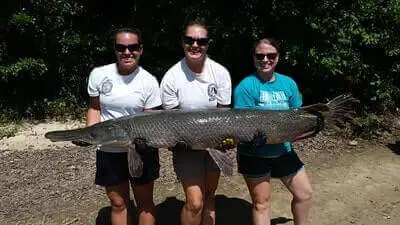
Best Lures For Alligator
- Topwater Lures
Topwater lures can be effective for enticing alligator gar to strike on the surface, creating thrilling moments for anglers. These lures mimic injured prey, causing commotion on the water’s surface, which can attract the attention of nearby gar.
Anglers can use various types of topwater lures, such as floating plugs, buzzbaits, or surface poppers, to elicit explosive strikes from alligator gar. When using topwater lures for alligator gar fishing, anglers should target areas with shallow water, particularly in the early morning or late evening when gar are more active near the surface.
It’s essential to use heavy-duty tackle and strong hooks to handle the powerful jaws of alligator gar. For more tips on using topwater lures for alligator gar fishing, anglers can refer to resources provided by the Texas Parks and Wildlife Department.
2. Spinnerbaits
Spinnerbaits are versatile lures that can effectively attract and entice alligator gar in various water conditions. These lures consist of a wire frame with one or more spinning blades and a skirted jig head, creating vibration and flash underwater.
Anglers can customize spinnerbaits by selecting blade sizes and colors to match the water conditions and mimic the movement of prey. When targeting alligator gar with spinnerbaits, anglers should focus on casting near submerged structures, such as fallen trees or brush piles, where gar are likely to lurk. It’s crucial to use heavy-duty spinnerbaits with strong hooks to withstand the gar’s sharp teeth and powerful strikes.
Anglers should retrieve spinnerbaits at a moderate pace, allowing the blades to spin and create enticing movement in the water. For additional guidance on using spinnerbaits for alligator gar fishing, anglers can consult resources provided by the Louisiana Department of Wildlife and Fisheries.
3. Swimbaits
Swimbaits are lifelike artificial lures that imitate the appearance and swimming action of baitfish, making them effective for targeting alligator gar. These lures come in various sizes and colors, allowing anglers to match the hatch and mimic the natural prey of alligator gar.
Anglers can rig swimbaits weedless or on weighted hooks to achieve different depths and presentations, depending on the water conditions and the behavior of the gar. When fishing with swimbaits for alligator gar, anglers should focus on casting near areas with submerged vegetation, rocky structures, or drop-offs where gar are likely to ambush prey. It’s essential to use heavy-duty tackle and strong hooks to handle the powerful strikes of alligator gar.
Anglers can experiment with different retrieve speeds and techniques to find the most effective presentation for enticing gar to strike. For further information on using swimbaits for alligator gar fishing, anglers can refer to resources provided by the Florida Fish and Wildlife Conservation Commission.
Alligator Gar Fishing Tips
- Alligator gar spawns in brackish water in spring.
2. The best time to hunt for alligator gar is late summer when it is hot and dry at the end of June, July, and August.
3. Gar is sensitive to sound. Don’t use a motorboat as it will spook the fish. A rowboat or a drift boat is preferable.
4. Alligator gar can be found in slow-moving waters, “dead lakes”, creeks, lakes, rivers, and ponds.
5. The alligator gar is more actively feeding when the temperature is in the range of 70 to 90 degrees. They are more active on the surface of the water when the temperature rises to this level.
6. Bowfishing, fly fishing, jug fishing, topwater fishing, rod and reel, limblines, and trotlines are different fishing methods used by anglers when fishing for alligator gar.
7. A 7-8 foot fishing rod and a high-quality spinning reel will work.
8. Use a wire or cut-resistant leader line to withstand the sharp teeth. Alligator gar’s mouth is lined with very sharp teeth.
9. When using cut bait, use 4-inch chunks of cut carp or shad as bait.
10. Always give the alligator gar time to take the bait before setting the hook.
11. Always secure a rope around the head of the alligator gar when removing the hook.
12. When wrestling with the gar, work it to tire it out. This will reduce the strain on the line and allow you to eventually reel it in.
13. Common carp, mullet, shad, buffalo, and tilapia are some of the baits used when fishing for alligator gar.
14. Live bait cut up into chunks is the best bait to use when fishing for this fish.
15. Sometimes gar will drop your bait, just wait as most times, it will go for the bait.
16. When on a boat fishing for gar, keep an eye out for schools of baitfish. If you see baitfish breaking the water as if they are being pursued, chances are this fish is the predator.
17. Always cast your line to the deeper parts of the channel.
18. If this fish is hooked on your line, it will move fast across the water or dive deeper into the water. When this happens, lower your fishing rod towards the gar, and after the line pulls tight, wait around 10 seconds.
19. For hook removal, use cut-resistant gloves or long-handled pliers regardless of their size.
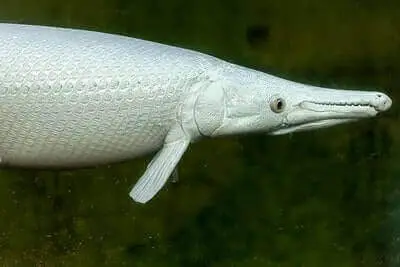
The Bottom Line
Fishing for alligator gar is a challenging and exciting experience. This is a very large fish with rows of sharp teeth. There are many fishing methods that are used by anglers such as fly fishing, topwater fishing, rod and reel, jug fishing, and bow fishing.
Live bait is the best bait to use when fishing for alligators, although other baits are also very effective. In this article, we have shared information on how to catch alligator gar.
If you are also interested in other fish, you can read how to catch Atlantic salmon, how to catch black grouper, how to catch arctic char, how to catch albacore tuna, how to catch tilefish, and how to catch cubera snapper.